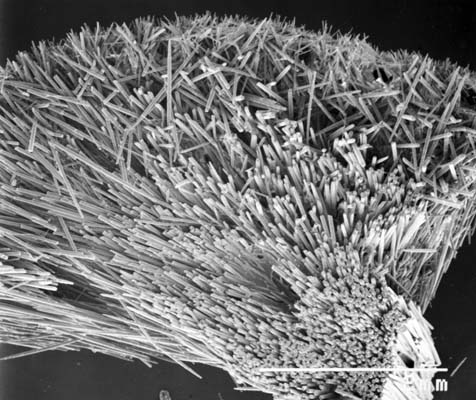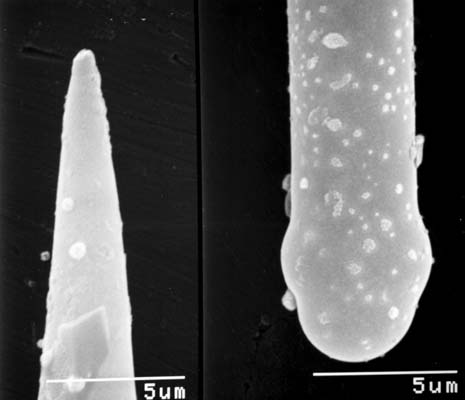Morphological description (show/hide)
| Thickly encrusting, subspherical, insinuating into cavities, up to 22mm thick above the substrate, living under dead coral boulder. | | Oscules. Not visible. | | Colour. Pale yellow-brown alive (Munsell 2.5Y 8/8), pale brown in ethanol. | | Compressible, harsh, slimy exterior, spiky. | | Opaque, uneven, unoramented but hispid. | | Choanosomal skeleton. Slightly compressed, dense axial skeleton composed of larger choanosomal styles, irregularly halichondrioid reticulate in axis but more regular near periphery, where tracts form whispy multispicular ascending lines, subectosomal skeleton slightly cavernous, with straight, dense tracts of choanosomal styles ascending to the surface in nearly radial bundles, smaller styles also scattered throughout the skeleton in between major tracts. Collagen sparse but darkly pigmented in choanosomal mesohyl. | | Dense, erect or paratangential layer of small styles forming a continuous palisade of spicules projecting beyond the surface, supported below by larger choanosomal styles extending from subectosomal region (the latter not protruding above the surface), and small amounts of darkly pigmented collagen associated with ectosomal brushes. | | Spicules. Styles in two size classes: larger choanosomal styles straight or slightly curved near basal end, sharply pointed or with slightly stepped points, evenly rounded, tapering (hastate) or subterminal centrotylote (faintly swollen) bases, and usually thickest towards the pointed end rather than the base (length 775-(1022.4)-1310ï¾µm, width 18-(26.9)-33ï¾µm), smaller ectosomal styles straight, fusiform, sharply pointed, with subtylote or subterminal centrotylote bases (length 125-(219.0)-288ï¾µm, width 3-(5.6)-8ï¾µm). | | nil. |
|
Reference (show/hide)
| Erpenbeck D, Hall K, Alvarez B, Büttner G, Sacher K, Schätzle S, Schuster A, Vargas S, Hooper JNA, Wörheide G (in press) The phylogeny of halichondrid demosponges: past and present re-visited with DNA-barcoding data. The phylogeny of halichondrid demosponges: past and present re-visited with DNA-barcoding data. Organisms Diversity & Evolution. |
|





